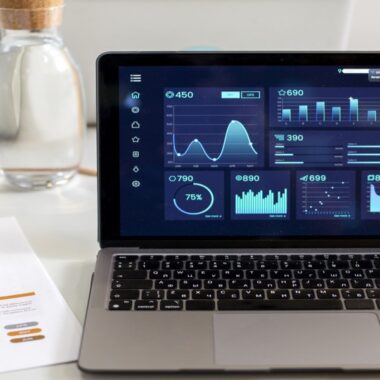Summary: Data Analytics can revolutionize sustainable energy. Data collection from smart meters, weather stations, and sensors empowers us to predict energy demand and production. This allows for optimized energy use, efficient integration of renewables, and smarter grid management. Data visualization tools translate complex data into clear visuals, fostering stakeholder engagement and driving progress towards a clean energy future.
Introduction
The world is facing a critical juncture. The ever-growing demand for energy is colliding head-on with the need to transition to a sustainable future. Fortunately, a powerful tool sits at our disposal: Data Analytics. By harnessing the vast amount of data generated in the energy sector, we can unlock a new era of sustainable energy solutions.
This blog delves into the transformative potential of Data Analytics in building a clean energy future. We’ll explore how data collection, analysis, and visualization are revolutionizing every aspect of the energy landscape, from production and consumption to grid management and stakeholder engagement.
The energy sector generates a staggering amount of data. From weather patterns and solar irradiance to smart meter readings and power plant outputs, this data holds the key to optimizing energy production, distribution, and consumption. Data Analytics acts as the decoder ring, unlocking valuable insights from this vast ocean of information.
Through a combination of statistical analysis, machine learning techniques, and data visualization tools, data scientists are transforming the energy sector. They are enabling:
Improved forecasting: Predicting energy demand and production fluctuations allows for a more balanced and efficient grid.
Enhanced efficiency: Identifying areas of energy waste empowers us to optimize consumption and reduce our carbon footprint.
Smarter grids: Data-driven insights pave the way for the development of smart grids that can dynamically adjust to real-time conditions.
Informed decision-making: Data empowers stakeholders to make data-driven decisions that promote sustainable energy development.
Data Collection and Management in Sustainable Energy

The success of any Data Analytics endeavor hinges on the quality and accessibility of its data. In the realm of sustainable energy, data collection plays a critical role in informing strategies and driving progress. This section dives into the various sources of data and the importance of robust data management systems.
Smart Meters
These ubiquitous devices continuously monitor energy consumption in homes and businesses. They provide granular data on user behaviour, peak demand periods, and overall energy usage patterns.
Weather Stations
Weather data is crucial for predicting renewable energy production, particularly for wind and solar power sources. Real-time and historical weather data helps assess wind speeds, solar irradiation levels, and potential cloud cover, enabling better forecasting of renewable energy output.
Sensor Networks
A network of sensors strategically deployed across power grids collects real-time data on power flows, voltage fluctuations, and environmental conditions. This data allows for early detection of potential equipment failures, minimizing downtime and ensuring grid stability.
Satellite Imagery
Data obtained from satellites can be used to assess potential renewable energy resources. Satellite imagery provides insights into solar irradiation levels across vast areas, helping identify optimal locations for solar power plants.
Beyond these primary sources, additional data points can be valuable depending on the specific application. This might include:
Geographical Information Systems (GIS) data: Understanding geographical data, like population density and land use patterns, can inform decisions about grid infrastructure development and renewable energy project placement.
Historical energy consumption data: Analyzing past consumption patterns allows for identifying trends and seasonal variations, aiding in demand forecasting and resource allocation.
Importance of Data Management
With such a diverse range of data sources, robust data management systems are essential. These systems ensure that the data collected is:
Accurate
Data quality is paramount. Inaccurate data leads to unreliable analysis and misleading insights. Data validation and cleaning procedures are crucial to ensure the integrity of the data set.
Accessible
The collected data needs to be readily available in a format that can be easily integrated with Data Analytics tools and analytics platforms. Standardized data formats and centralized storage solutions facilitate accessibility.
Secure
Protecting sensitive data from unauthorized access or breaches is critical. Implementing robust cybersecurity measures is essential to maintain data privacy and ensure the integrity of the information collected.
By establishing a well-defined data collection and management strategy, organizations in the sustainable energy sector can harness the power of data to optimize energy production and consumption, drive efficiency improvements, and ultimately contribute to a cleaner energy future.
Predictive Analytics for Energy Production and Demand Forecasting

Imagine a world where energy production seamlessly aligns with demand, minimizing waste and maximizing efficiency. This is the vision that predictive analytics brings to the forefront of sustainable energy solutions.
By leveraging historical data, real-time information, and sophisticated algorithms, data scientists can generate accurate forecasts for both energy production and demand. This empowers stakeholders to make informed decisions that benefit the environment and consumers alike.
Predictive analytics plays a multifaceted role in the sustainable energy landscape. Let’s delve into some key applications with real-world examples:
Demand Forecasting
Energy demand fluctuates significantly based on weather, holidays, and economic activity. Traditionally, forecasting relied on historical averages, often leading to inefficiencies.
Solution: Predictive analytics utilizes historical data alongside weather forecasts and economic indicators to create highly accurate demand models. This allows utilities to:
Example: A utility company in Texas can use predictive analytics to anticipate the surge in demand during summer heat waves. This empowers them to source additional renewable energy or purchase power from neighbouring grids, preventing brownouts and ensuring grid stability.
Renewable Energy Production Forecasting
Renewable energy sources like solar and wind are inherently variable. Predicting their output with traditional methods proves challenging.
Solution: Predictive models incorporate historical production data with weather forecasts, allowing for a more accurate prediction of solar irradiation levels and wind speeds. This empowers utilities to:
Example: A wind farm operator in Denmark can leverage predictive analytics to anticipate wind generation based on weather patterns. This allows them to integrate their power output into the grid more effectively and optimize energy trading strategies.
Equipment Failure Prediction
Unexpected equipment failures can disrupt energy production and distribution. Traditional maintenance schedules are reactive, leading to downtime and potential damage.
Solution: Predictive analytics utilizes sensor data from power plants and grid infrastructure to identify anomalies that signal potential equipment failures. This empowers utilities to:
Example: A solar power plant in California can analyze sensor data from solar panels and inverters. Predictive models can identify potential issues like overheating or performance degradation, allowing for proactive maintenance and minimizing downtime.
The future of sustainable energy hinges on our ability to predict and adapt. Predictive analytics empowers us to do just that, paving the way for a cleaner, more efficient energy future.
Optimization Techniques for Energy Efficiency

Data Analytics isn’t just about predicting the future; it’s also about optimizing the present. By analyzing energy consumption data, data scientists can pinpoint areas of inefficiency. This empowers us to:
Identify Energy-intensive Buildings
Buildings account for a significant portion of energy consumption. Data can identify buildings with inefficient systems and prioritize retrofitting efforts.
Optimize Industrial Processes
Manufacturing facilities often have hidden inefficiencies. Data analysis can identify opportunities for process optimization to reduce energy waste.
Promote Behavioural Change
Analyzing smart meter data can reveal household energy consumption patterns. Personalized recommendations can be provided to consumers, encouraging them to adopt energy-saving practices.
These optimizations translate into real-world benefits. Reduced energy consumption lowers costs for both consumers and utilities while minimizing our dependence on fossil fuels.
Smart Grid and IoT Applications
The Internet of Things (IoT) is revolutionizing the energy sector. Sensors embedded in everything from appliances to power lines are constantly feeding data into the system. This real-time data empowers the development of smart grids:
Dynamic Pricing
Based on real-time demand and supply, smart grids can adjust electricity prices, incentivizing consumers to shift consumption to off-peak hours.
Self-healing Grids
Data Analysis can identify and localize grid faults, enabling faster repairs and minimizing downtime.
Integration of Renewable
Smart grids can seamlessly integrate renewable energy sources with traditional power plants, ensuring grid stability despite fluctuating renewable energy.
Data Visualization for Stakeholder Engagement
Raw numbers can be overwhelming, but data is powerful. Data visualization tools translate complex data sets into clear and compelling visuals like charts, graphs, and interactive dashboards. These visualizations play a crucial role in stakeholder engagement:
Communicating Insights
Data visualizations effectively communicate complex data insights to a broad audience, including policymakers, investors, and the general public.
Building Support
By showcasing the benefits of sustainable energy solutions through clear visuals, data visualizations can garner support for renewable energy initiatives and energy efficiency programs.
Tracking Progress
Dashboards can be used to track progress towards sustainable energy goals, highlighting achieved milestones and areas for further improvement. Data visualization bridges the gap between data and action, fostering engagement and driving progress towards a sustainable energy future.
Future Trends and Opportunities
The future of data science in sustainable energy is brimming with exciting possibilities that promise to accelerate our journey towards a clean energy future. Here are some key trends and opportunities to watch:
Artificial Intelligence (AI)
Machine Learning algorithms are already playing a crucial role in predictive analytics. However, the future holds even greater potential. AI advancements will enable the development of even more sophisticated models that can analyze vast datasets in real-time, leading to:
Hyper-accurate Forecasting: AI will further refine our ability to predict energy demand, renewable energy production, and equipment failures, allowing for even more efficient and flexible grid management.
Autonomous Optimization: AI-powered systems could potentially make real-time adjustments to grid operations, optimizing energy flows and promoting grid stability.
Blockchain Technology
Blockchain, the technology behind cryptocurrencies, can play a transformative role in the energy sector. Its secure and transparent nature can be harnessed for:
Peer-to-peer Energy Trading: Imagine a future where homes with rooftop solar panels can sell excess energy directly to their neighbors. Blockchain can facilitate secure and transparent peer-to-peer energy transactions.
Decentralized energy production: Blockchain can empower local communities to invest in and manage their own renewable energy microgrids, fostering a more decentralized and resilient energy system.
Advanced Grid Analytics
The ever-growing volume of data collected from smart meters, sensors, and other sources presents a unique challenge and opportunity. Advanced analytics tools, powered by machine learning and artificial intelligence, will be crucial for:
Unveiling Hidden Patterns: By analyzing massive datasets, we can uncover previously hidden patterns in energy consumption and grid behavior. This can lead to targeted interventions and optimize energy use across the entire system.
Cybersecurity Advancements: As data collection continues to expand, robust cybersecurity measures will be essential to protect critical infrastructure from cyberattacks.
These are just a few of the exciting trends shaping the future of data science in sustainable energy. By embracing continuous innovation and fostering collaboration between data scientists, energy experts, and policymakers, we can harness the power of data to unlock the full potential of a sustainable energy future.
Frequently Asked Questions
How Can Individuals Contribute to a Data-driven Sustainable Energy Future?
Individuals can contribute by participating in smart meter programs, adopting energy-efficient appliances, and using energy-saving practices in their homes. Sharing anonymized data with utilities can also empower them to make better data-driven decisions.
What Are The Challenges Associated With Using Data Analytics in Sustainable Energy?
Data security and privacy are crucial concerns. Additionally, ensuring data quality and accessibility across different platforms and systems remains a challenge.
What Skills Are Required to Work in The Field of Data Analytics for Sustainable Energy?
A strong foundation in statistics, machine learning, and data visualization tools is essential. Additionally, domain knowledge of the energy sector and an understanding of renewable energy technologies are valuable assets.
Conclusion
Data Analytics is no longer a luxury but a necessity in the quest for a sustainable energy future. By harnessing the power of data, we can unlock a future powered by clean energy sources, optimized for efficiency, and built on informed decision-making.
As we move forward, continuous innovation and collaboration between data scientists, energy experts, and policymakers will be crucial in realizing this vision. Let’s embrace the power of data and illuminate the path towards a brighter, cleaner energy future.




